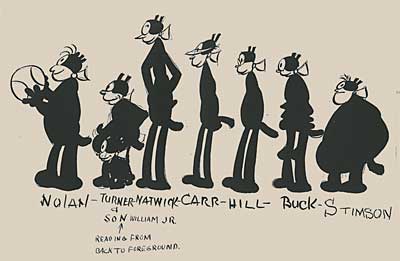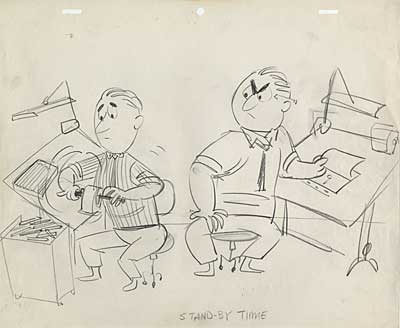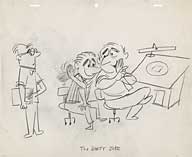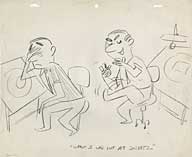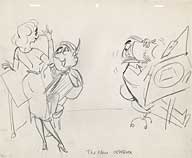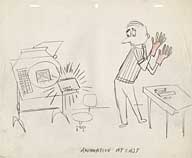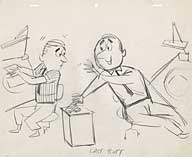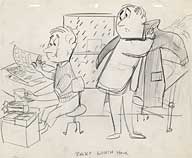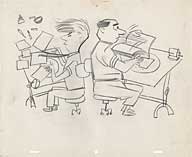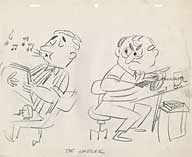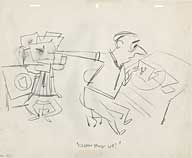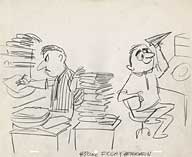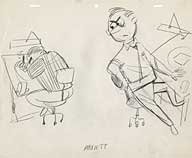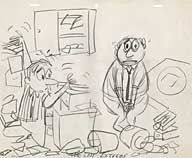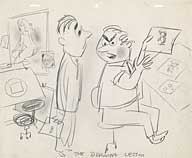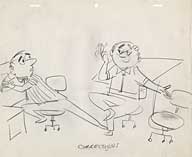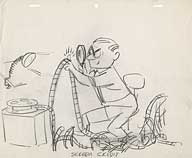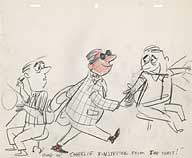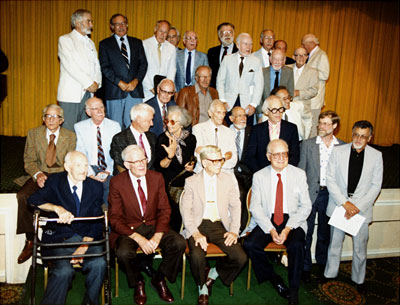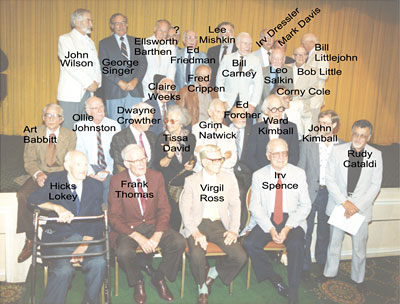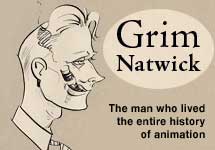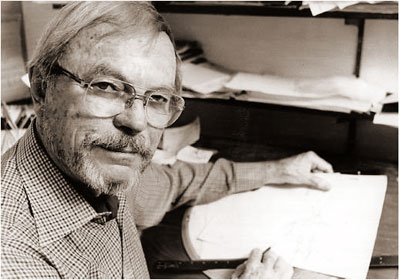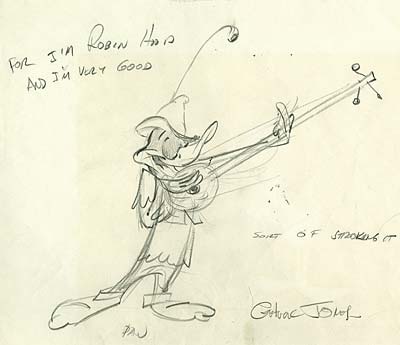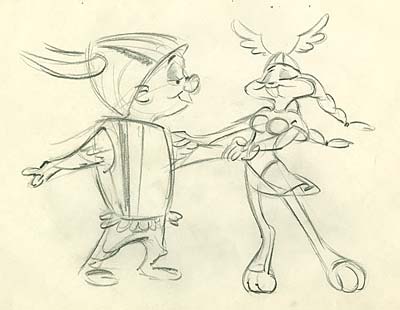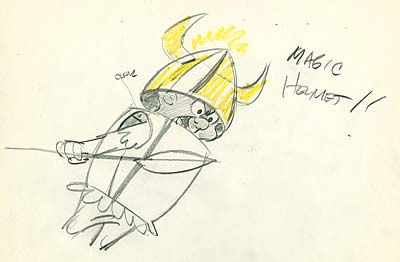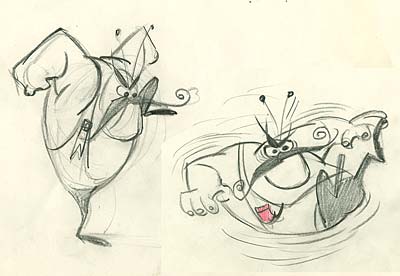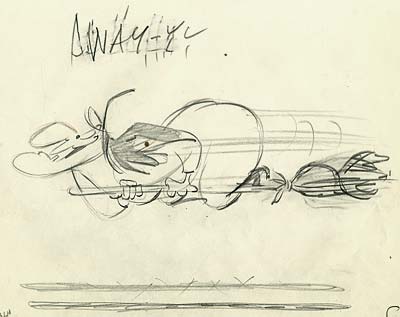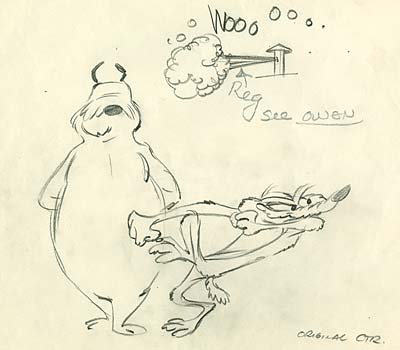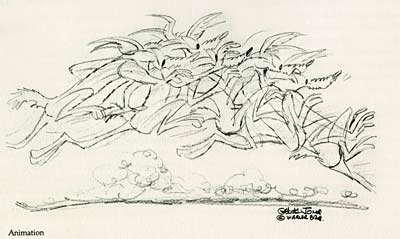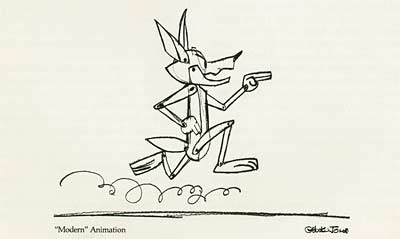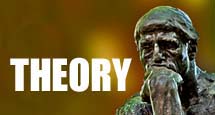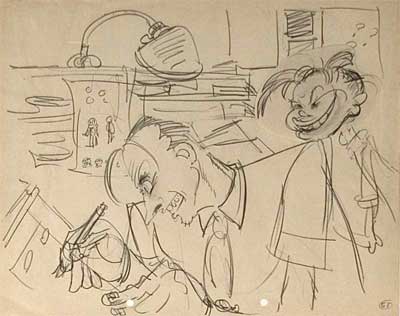
Grim Natwick with his "kid assistant",
Chuck Jones (Iwerks/1933)
PART FOUR: GRIM’S STUDIO GAG DRAWINGS AND CARICATURES
Like most animators, Grim Natwick had a unique sense of humor. He was famous for his limericks, scribbled in on the margins of his animation drawings. Here are a couple of doozies by Grim…
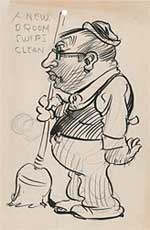
![]() I’ve broken my friendship with Babbitt
I’ve broken my friendship with Babbitt
Because of his slovenly habit
Of eating out loud
And I’ve never been proud
Of his nibbling bones like a rabbit!
"It’s true!" said the painter to the prude
"I sketch all my ladies in the nude
A dress is OK
For a window display
But on my girls, it wouldn’t improve."
A nail sitting Hindoo said "I
Have perched here and gazed at the sky
Till I’ve punctured my hide
Fillagreed my back side
I’m damned if I’ve ever known why!"
Grim prized his studio gag drawings above all the others in his collection. He described how they came to be for me one day…
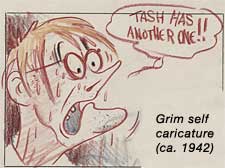
![]() "At Lantz, we all worked very hard. But occasionally, we would need to take a break and have fun. One of us would draw a quick caricature of one of the other animators, or do a cartoon on a funny situation that had taken place. He’d tiptoe out into the hallway and pin it up on the board and sneak back to his desk. Pretty soon, someone else would come along and see the drawing and run back to his desk to answer the gag, pinning up their sketch on the board alongside the other one. By the end of the day, the board would be covered with funny drawings. We’d pull them all down and start all over again the next day."
"At Lantz, we all worked very hard. But occasionally, we would need to take a break and have fun. One of us would draw a quick caricature of one of the other animators, or do a cartoon on a funny situation that had taken place. He’d tiptoe out into the hallway and pin it up on the board and sneak back to his desk. Pretty soon, someone else would come along and see the drawing and run back to his desk to answer the gag, pinning up their sketch on the board alongside the other one. By the end of the day, the board would be covered with funny drawings. We’d pull them all down and start all over again the next day."
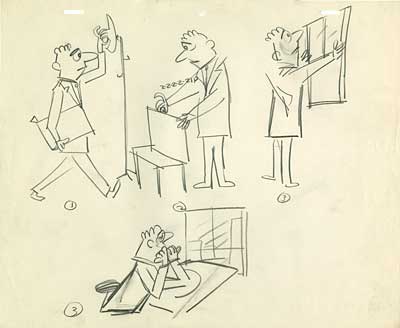
Grim’s most treasured folder of drawings was the gag
sketches involving Lu Guarnier’s window at UPA New York.
A Series Of Studio Gag Drawings From UPA NY (ca. 1955)
As an "animation historian", I’ve never been as interested in the dates and figures related to animation as much as the process- and how it felt to be a part of a golden age studio. These sketches give a clear indication of that, better than words could ever tell…
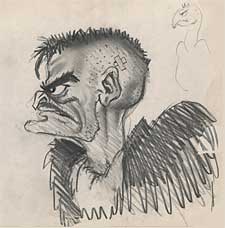
![]() Well… It says "conclusion" up there, so I better get to telling you why Grim Natwick was the greatest animator who ever lived. I don’t know how many readers of this blog have had a chance to digest all of my articles from this week. It certainly has been very difficult to summarize a career as long and varied as Grim Natwick’s. I had always intended to write a book on Grim, but the weblog may actually be the best format for telling his story.
Well… It says "conclusion" up there, so I better get to telling you why Grim Natwick was the greatest animator who ever lived. I don’t know how many readers of this blog have had a chance to digest all of my articles from this week. It certainly has been very difficult to summarize a career as long and varied as Grim Natwick’s. I had always intended to write a book on Grim, but the weblog may actually be the best format for telling his story.
Books on animation history are usually organized by studio. If you read Leonard Maltin’s great book, Of Mice & Magic, Grim Natwick’s name is sprinkled throughout six chapters. That might give you the idea that Grim was a marginal figure who moved around a lot. But when you read his life story chronologically- not inserted into six separate chapters- you realize that Grim’s life story IS the story of the history of animation. The history of animation isn’t the story of studios and characters- it’s the story of the artists whose talents created the magic up there on the screen.
Grim Natwick was the greatest animator who ever lived. But I still haven’t told you why yet!
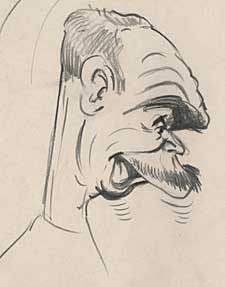
![]() Grim loved to tell long, convoluted stories that would inevitably ramble back around to his point. Here’s a story like that…
Grim loved to tell long, convoluted stories that would inevitably ramble back around to his point. Here’s a story like that…
Antran Manoogian, president of ASIFA-Hollywood heard that Grim was in town and was celebrating a birthday, so he threw a party for him. As he was blowing out the candles, Grim announced that he was pleased to spend his 100th birthday in such fine company. Everyone in the room gasped. No one had any idea that it was Grim’s 100th birthday. The room burst into applause. Antran drove Grim home after the party. In the car, Grim was uncharacteristically quiet and sheepish. He finally said, "Young man, I have a confession to make… I told everyone that I was 100, but I’m only 97." Antran laughed and promised Grim that ASIFA would throw him an even better party in three years- the best birthday party ever.
Antran kept that promise. when Grim turned 100, ASIFA threw a huge celebration at the Sportsman’s Lodge in Studio City. Hundreds of people attended, including co-workers from every studio Grim ever worked with. Grim described it as "the most illustrious gathering of animators since Winsor McCay’s testimonial dinner in the late 1920s". At the end of the evening an announcement was made for all of Grim’s former coworkers and assistants to gather on the stage for a photo. Animator, Michael Sporn recently posted this photo…
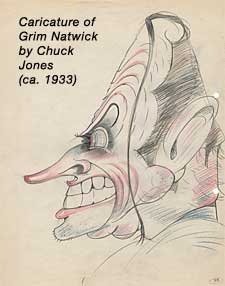
![]() Three of Grim’s former assistants were chosen to address the audience that evening… Walter Lantz (Hearst), Chuck Jones (Iwerks) and Marc Davis (Disney). All three spoke of Grim’s generosity and friendship. They credited Grim with teaching them their trade and inspiring them to become better artists. Those three men weren’t alone in that. Dozens of other great animators… Bill Littlejohn, Irv Spence, Willard Bowsky, Berny Wolf, Tissa David, Shamus Culhane- too many to mention- all traced their own accomplishments back to Grim’s example when they were just starting out. Grim’s "kid assistants" went on to form the artistic core of every major animation studio in the United States.
Three of Grim’s former assistants were chosen to address the audience that evening… Walter Lantz (Hearst), Chuck Jones (Iwerks) and Marc Davis (Disney). All three spoke of Grim’s generosity and friendship. They credited Grim with teaching them their trade and inspiring them to become better artists. Those three men weren’t alone in that. Dozens of other great animators… Bill Littlejohn, Irv Spence, Willard Bowsky, Berny Wolf, Tissa David, Shamus Culhane- too many to mention- all traced their own accomplishments back to Grim’s example when they were just starting out. Grim’s "kid assistants" went on to form the artistic core of every major animation studio in the United States.
Grim is the greatest animator who ever lived, not just for his own accomplishments, but for what he shared with the people he worked with. Animation was never just a job to him. It was his passion. He instilled that passion in his assistants, and those assistants went out into the world and became great themselves. Grim Natwick was the catalyst who made the entire history of animation possible. That’s why he is the greatest animator who ever lived.
EXHIBIT CATALOG: GRIM NATWICK’S CARICATURES & GAG DRAWINGS
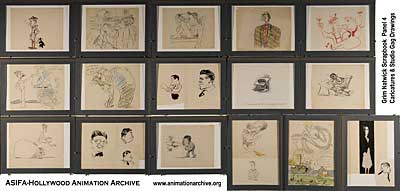
Top Row: Caricatures of Grim (left to right) Self caricature* (ca.1926/Hearst) / Self caricature with assistant, Chuck Jones* (1933/Iwerks) / Caricature of Grim on studio outing to Catalina by Chuck Jones (1933/Iwerks) / Caricature of Grim in his fancy suit (ca. 1942/Lantz) / Caricature of Grim at his "studies in Vienna" possibly by Art Heinemann (UPA ca.1955)
Middle Row: (left to right) Two sketches depicting the love/hate relationship between Emery Hawkins and Grim Natwick* (ca. 1944/Lantz) / Bill Nolan at the Krazy Kat Studio* (ca. 1926) / Studio gag drawing (ca. 1959/Robert Lawrence) / Studio gag drawing* (ca. 1936/Disney)
Bottom Row: Tony Sgroi and "Bugs" Hardaway (ca. 1947/Lantz) / Manny Gould* & Sammy Stimpson* (ca. 1926/Krazy Kat Studio) / Bill Nolan with a cold* (ca. 1919/Hearst) / top: Dick Lundy* (ca. 1936/Disney) bottom: Freddie Moore* (ca. 1936/Disney) / Studio gag drawings* (ca. 1929/Fleischer) / Caricatures of Jack Carr* (ca.1923/Krazy Kat Studio)
* denotes a drawing by Grim Natwick
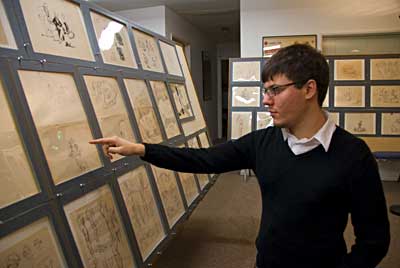
Assistant Archivist, Joseph Baptista views the exhibit.
GRIM NATWICK’S SCRAPBOOK
This travelling exhibit has appeared at the ASIFA-Hollywood Animation Archive in Burbank, CA and at the South Wood Historical Society Museum in Wisconsin Rapids, WI, birthplace of Grim Natwick.
Stephen Worth
Director
Animation Resources
This posting is part of an online exhibit entitled Grim Natwick’s Scrapbook.
THIS IS JUST THE TIP OF THE ICEBERG!
Animation Resources has been sharing treasures from the Animation Archive with its members for over a decade. Every other month, our members get access to a downloadable Reference Pack, full of information, inspiration and animation. The RefPacks consist of e-books jam packed with high resolution scans of great art, still framable animated films from around the world, documentaries, podcasts, seminars and MORE! The best part is that all of this material has been selected and curated by our Board of professionals to aid you in your self study. Our goal is to help you be a greater artist. Why wouldn’t you want to be a member of a group like that?
Membership comes in three levels. General Members get access to a bi-monthly Reference Pack as well as a Bonus RefPack from past offerings in the in-between months. We offer a discounted Student Membership for full time students and educators. And if you want to try out being a member, there is a Quarterly Membership that runs for three months.
JOIN TODAY!
https://animationresources.org/membership/levels/
FREE SAMPLES!
Not Convinced Yet? Check out this SAMPLE REFERENCE PACK! It will give you a taste of what Animation Resources members get to download every other month! That’s 560 pages of great high resolution images and nearly an hour of rare animation available to everyone to download for FREE! https://animationresources.org/join-us-sample-reference-pack/
![]()
![]() Animation Resources depends on your contributions to support its projects. Even if you can’t afford to join our group right now, please click the button below to donate whatever you can afford using PayPal.
Animation Resources depends on your contributions to support its projects. Even if you can’t afford to join our group right now, please click the button below to donate whatever you can afford using PayPal.














